

This article is an excerpt from the Shortform book guide to "How to Be an Antiracist" by tIbram X. Kendi. Shortform has the world's best summaries and analyses of books you should be reading.
Like this article? Sign up for a free trial here .
What are some How to Be an Antiracist quotes? How does each quote highlight an important concept from Ibram X. Kendi’s book?
How to Be an Antiracist quotes identify the key themes in Ibram X. Kendi’s book. Starting with the concept of antiracism and myth of neutrality and ending with the idea that racism is like a cancer, these How to Be an Antiracist quotes will help you remember the important messages of the book.
Keep reading for four How to Be an Antiracist quotes.
How to Be an Antiracist Quotes
“The opposite of racist isn’t ‘not racist.’ It is ‘anti-racist.’ What’s the difference? One endorses either the idea of a racial hierarchy as a racist, or racial equality as an anti-racist. One either believes problems are rooted in groups of people, as a racist, or locates the roots of problems in power and policies, as an anti-racist. One either allows racial inequities to persevere, as a racist, or confronts racial inequities, as an anti-racist. There is no in-between safe space of ‘not racist.”
The first of the quotes from How to Be an Antiracist is about the nature of Race neutral programs can actually be more dangerous than the agenda of the alt right. While the alt right is unlikely to actually create a White ethnostate, race neutrality has a track record of leaving policies that create inequity in place and striking down programs that create equity.
Additionally, race neutrality often goes hand-in-hand with ideas around ignoring the existence of race (the notion of being “color blind”). While race is a power construct, not a meaningful scientific category, it still affects everyone’s lives. Pretending it doesn’t exist allows racists to carry out business as usual—if we ignore race, then we’re blind to racial inequity. Dispensing with racial groups will be one of the very last steps in the struggle to end racism, not the first.
There is no in-between when it comes to antiracism and racism—anything that’s not antiracist is racist. Likewise, there is no such thing as a “neutral policy”: All policies and ideas either advance or hamper equality.
(Shortform example: Racist policies have created funding imbalances between Black and White schools. A scholarship program open only to Black people is antiracist because it strives for educational equality between racial groups. Axing this scholarship program because White people aren’t allowed to apply may seem “neutral,” but, in fact, canceling the program would be racist because it would mean canceling something that’s aimed at remedying the current funding imbalance and thereby promoting racial equity.)
“Black people are apparently responsible for calming the fears of violent cops in the way women are supposedly responsible for calming the sexual desires of male rapists.”
This is one of the How to Be an Antiracist quotes that show how Black people have to adjust their own actions to manage others’ racism.
Cops are scared of Black people, even unarmed kids. The US population is 13% Black, but people killed by police are disproportionately Black—in 2018, 21% of people killed by police were Black. White people are half as likely to be killed by police as Black people.
In reality, there are no inherently violent or dangerous races. Researchers have found that there’s a much stronger correlation between unemployment and violent-crime levels than race and violent crime levels, for example:
- A study of youth data from 1976-1989 found that young White males did less violent crime than Black ones, however, when the researchers looked at employed young males, there were no differences.
- Another study found that a 2.5% decrease in unemployment created a decrease in robbery, auto theft, larceny, and burglary, between 1992 and 1997.
- Karen F. Parker, a sociologist, found that between 1990 and 2000, an increase in Black-owned businesses reduced Black youth violence.
Additionally, all-Black neighborhoods have varying levels of crime. If Black people were inherently violent, crime levels in all-Black neighborhoods would be the same. Middle- and upper-income neighborhoods—in which people who have jobs tend to live—are less violent than low-income neighborhoods.
“Americans have long been trained to see the deficiencies of people rather than policy. It’s a pretty easy mistake to make: People are in our faces. Policies are distant. We are particularly poor at seeing the policies lurking behind the struggles of people.”
A racist policy is any law, procedure, process, guideline, or rule, written or unwritten, that causes or maintains racial inequity. “Systemic racism,” “structural racism,” and “institutional racism” are synonyms, but Ibram prefers to use “racist policy” because it’s more straightforward and concrete.
- Example #1: Some of Nixon’s fiercest criticism came from Black people and antiwar critics, so he created a policy to attack them. The policy allowed law enforcement to raid their homes and meetings in search of drugs.
- Example #2: Ohio required newly registered voters in the 2004 federal election to submit their voter-registration forms on a particular kind of expensive paper, which made it harder to register. The policy appeared to target all newly registered voters, irrespective of race, but a large percentage of newly registered voters were Black, meaning the policy caused racial inequity.
Racism is a combination of racist policies and ideas that causes and maintains racial inequities.
- An example of racism is the combination of policies that resulted in Black and Latinx people making up 56% of the prison population in 2016 even though they represent only around 25% of the US population. White people make up 30% of the prison population and 60% of the US population.
“Like fighting an addiction, being an antiracist requires persistent self-awareness, constant self-criticism, and regular self-examination.”
This is one of the hopeful How to Be an Antiracist quotes. While it is hard work, Ibram is saying that it is possible to do better. As Ibram worked with the Antiracism Center, he started having health problems. He lost weight, had digestive problems, and threw up. He went to see a doctor, who sent him for a precautionary colonoscopy. No one expected it to turn anything up—Ibram wasn’t in any of the risk groups for colon cancer. However, the colonoscopy determined he had stage-4 metastatic colon cancer, which kills about 88% of people within five years of diagnosis.
Ibram’s wife and mother had both survived breast cancer and during their battles, he’d noticed some parallels between cancer and racism. Cancer spreads throughout the whole body and affects all systems, like racism spreads across the country and intersects with bigotry. People deny both cancer and racism, and both can kill whole systems.
Ibram wanted to survive to spend more time with his family, be a better person, and write more, among other things. There are plenty of good reasons for society to want to survive racism too.
Ibram underwent six months of chemotherapy, which shrunk his tumors enough that he could be operated on, and during the operation, the surgeons found that the chemotherapy had fully erased the cancer.
Ibram believes that society can get through racism too, especially if we treat it like cancer instead of something that’s incurable. If racial inequity is a cancerous tumor, start by attacking it with the “chemotherapy” of antiracist policies. Then, surgically remove any lingering racist policies. Encourage a healthy diet of antiracist ideas. Then keep an eye on the system so that if any danger returns, it can be dealt with early, before it can spread again.

———End of Preview———
Like what you just read? Read the rest of the world's best book summary and analysis of Ibram X. Kendi's "How to Be an Antiracist" at Shortform .
Here's what you'll find in our full How to Be an Antiracist summary :
- What racism is and how it evolved
- How you might have subtle racist thoughts and not even be aware of them
- Why being "not racist" isn't good enough






